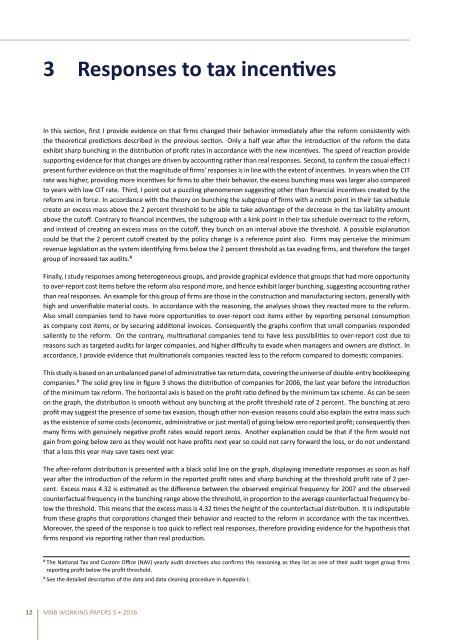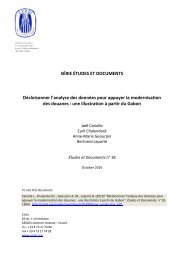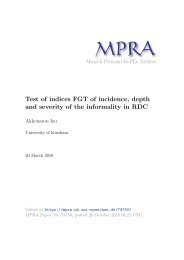You also want an ePaper? Increase the reach of your titles
YUMPU automatically turns print PDFs into web optimized ePapers that Google loves.
3 Responses to tax incenves<br />
In this secon, first I provide <strong>evidence</strong> on that firms changed their behavior immediately aer the reform consistently with<br />
the theorecal predicons described in the previous secon. Only a half year aer the introducon of the reform the data<br />
exhibit sharp <strong>bunching</strong> in the distribuon of profit rates in accordance with the new incenves. The speed of reacon provide<br />
supporng <strong>evidence</strong> for that changes are driven by accounng rather than real responses. Second, to confirm the casual effect I<br />
present further <strong>evidence</strong> on that the magnitude of firms’ responses is in line with the extent of incenves. In years when the CIT<br />
rate was higher, providing more incenves for firms to alter their behavior, the excess <strong>bunching</strong> mass was larger also compared<br />
to years with low CIT rate. Third, I point out a puzzling phenomenon suggesng other than financial incenves created by the<br />
reform are in force. In accordance with the theory on <strong>bunching</strong> the subgroup of firms with a notch point in their tax schedule<br />
create an excess mass above the 2 percent threshold to be able to take advantage of the decrease in the tax liability amount<br />
above the cutoff. Contrary to financial incenves, the subgroup with a kink point in their tax schedule overreact to the reform,<br />
and instead of creang an excess mass on the cutoff, they bunch on an interval above the threshold. A possible explanaon<br />
could be that the 2 percent cutoff created by the policy change is a reference point also. Firms may perceive the minimum<br />
revenue legislaon as the system idenfying firms below the 2 percent threshold as tax evading firms, and therefore the target<br />
group of increased tax audits.⁸<br />
Finally, I study responses among heterogeneous groups, and provide graphical <strong>evidence</strong> that groups that had more opportunity<br />
to over-report cost items before the reform also respond more, and hence exhibit larger <strong>bunching</strong>, suggesng accounng rather<br />
than real responses. An example for this group of firms are those in the construcon and manufacturing sectors, generally with<br />
high and unverifiable material costs. In accordance with the reasoning, the analyses shows they reacted more to the reform.<br />
Also small companies tend to have more opportunies to over-report cost items either by reporng personal consumpon<br />
as company cost items, or by securing addional invoices. Consequently the graphs confirm that small companies responded<br />
saliently to the reform. On the contrary, mulnaonal companies tend to have less possibilies to over-report cost due to<br />
reasons such as targeted audits for larger companies, and higher difficulty to evade when managers and owners are disnct. In<br />
accordance, I provide <strong>evidence</strong> that mulnaonals companies reacted less to the reform compared to domesc companies.<br />
This study is based on an unbalanced panel of administrave tax return data, covering the universe of double-entry bookkeeping<br />
companies.⁹ The solid grey line in figure 3 shows the distribuon of companies for 2006, the last year before the introducon<br />
of the minimum tax reform. The horizontal axis is based on the profit rao defined by the minimum tax scheme. As can be seen<br />
on the graph, the distribuon is smooth without any <strong>bunching</strong> at the profit threshold rate of 2 percent. The <strong>bunching</strong> at zero<br />
profit may suggest the presence of some tax evasion, though other non-evasion reasons could also explain the extra mass such<br />
as the existence of some costs (economic, administrave or just mental) of going below zero reported profit; consequently then<br />
many firms with genuinely negave profit rates would report zeros. Another explanaon could be that if the firm would not<br />
gain <strong>from</strong> going below zero as they would not have profits next year so could not carry forward the loss, or do not understand<br />
that a loss this year may save taxes next year.<br />
The aer-reform distribuon is presented with a black solid line on the graph, displaying immediate responses as soon as half<br />
year aer the introducon of the reform in the reported profit rates and sharp <strong>bunching</strong> at the threshold profit rate of 2 percent.<br />
Excess mass 4.32 is esmated as the difference between the observed empirical frequency for 2007 and the observed<br />
counterfactual frequency in the <strong>bunching</strong> range above the threshold, in proporon to the average counterfactual frequency below<br />
the threshold. This means that the excess mass is 4.32 mes the height of the counterfactual distribuon. It is indisputable<br />
<strong>from</strong> these graphs that corporaons changed their behavior and reacted to the reform in accordance with the tax incenves.<br />
Moreover, the speed of the response is too quick to reflect real responses, therefore providing <strong>evidence</strong> for the hypothesis that<br />
firms respond via reporng rather than real producon.<br />
⁸ The Naonal Tax and Custom Office (NAV) yearly audit direcves also confirms this reasoning as they list as one of their audit target group firms<br />
reporng profit below the profit threshold.<br />
⁹ See the detailed descripon of the data and data cleaning procedure in Appendix I.<br />
12 MNB WORKING PAPERS 3 • 2016





